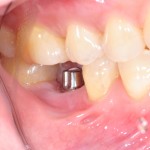
Following implant placement, a period of at least 3 months health is conventionally recommended to achieve osteointegration. The conventional or delayed healing approach require a prolonged treatment time. Consequently, early loading (implant loading between 48hours and 3 months) or immediate loading (implant loading within 48 hours) protocols have employed with studies suggesting that immediate loading (IL) is a predictable treatment option for single implant restorations.
The aim of this review was to compare the clinical outcomes between immediate and non-immediate (early or conventional) loading in single-implant restorations.
Methods
Searches were conducted in the PubMed, Embase, Cochrane Library, Web of Science, and ClinicalTrials.gov database. Randomised controlled trials (RCTs) comparing dental implants (placed immediately, early, or late) with immediate prosthetic loading compare with conventional loading with a follow up of at least 2 years were considered. Two reviewers independently selected studies extracted data and assessed risk of bias using the Cochrane tool with disputes being resolved by discussion with a third reviewer. The certainty of the evidence was assessed using GRADE. Dichotomous outcomes were reported as risk ratios (RR) with 95% confidence intervals (CI) and continuous outcomes as mean differences (MD) with 95%CI.
Results
- 10 RCTs involving a total of 423 patients and 522 implants (256 immediate loading, non-immediate loading) were included.
- Duration of follow up ranged from 24 to 72 months.
- 2 RCTs were considered to be at low risk of bias and 8 at moderate risk.
- Overall survival rates at patient level were 8% for IL implants and 98.4% for non-immediately loaded (non-IL) implants. Survival rates at implant level were 97.6% and 98.1%, respectively.
- Meta-analyses showed no significant difference in implant failure between IL and non-IL implant at patient or implant level: –
- Patient level RR = 1.29 (95%CI: 0.35 to 4.78)
- Implant level RR = 1.19 (95%CI: 0.40 to 3.51).
- No significant difference was seen in marginal bone loss (MBL) failure between IL and non-IL implants MD = -0.04 (95%CI: -0.16 to 0.08)
Conclusions
The authors concluded: –
Immediate loading (IL) shows predictable and reliable clinical outcomes at long- term follow-up when applied to single- implant restorations in carefully selected cases. An insertion torque of 30–35N∙cm is acceptable for the use of IL for a single implant. A screw-retained prosthesis retention type, implant location in the mandible, and implant with non-occlusal contact may be important to ensure the prognosis of IL of a single implant.
Comments
Several major databases were searched and 10 RCTs were identified. None of the included studies was considered to be at high risk of bias, the majority being at moderate risk. All the studies involved patients in good clinical health and 4 studies had follow up periods of 5 years or more. The authors used a broad definition for implant failure defined as ‘the presence of any mobility, pain, infection, or implant loss during the observation period’ with data presented both at the patient and implant level. However, the number of implant failures in the included studies was small with only 7 patients in total suffering with an implant failure and 11 implant losses in total. This has implications in terms of assessing the findings regarding the main outcomes as well as the subgroup analyses conducted. With increasing numbers of implants being placed there is a need for better quality data on longer term survival periods of 10 years or more. Well-conducted and reported prospective studies conducted in a broader range of patients are needed to provide better data on the prognosis of IL implants.
Links
Primary Paper
Zhao G, Zhou Y, Shi S, Liu X, Zhang S, Song Y. Long-term clinical outcomes of immediate loading versus non-immediate loading in single-implant restorations: a systematic review and meta-analysis. Int J Oral Maxillofac Surg. 2022 Apr 13:S0901-5027(22)00136-9. doi: 10.1016/j.ijom.2022.03.057. Epub ahead of print. PMID: 35430123.
Other references
Dental Elf – 14th Oct 2019
